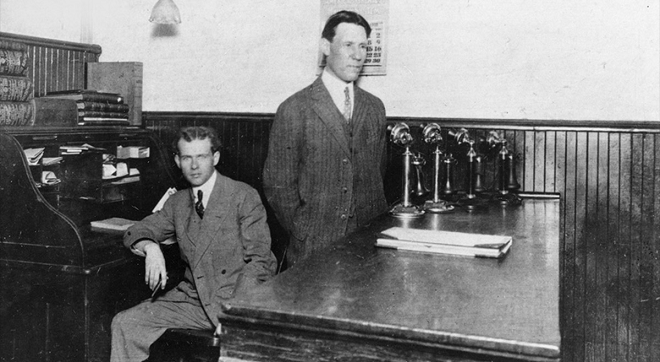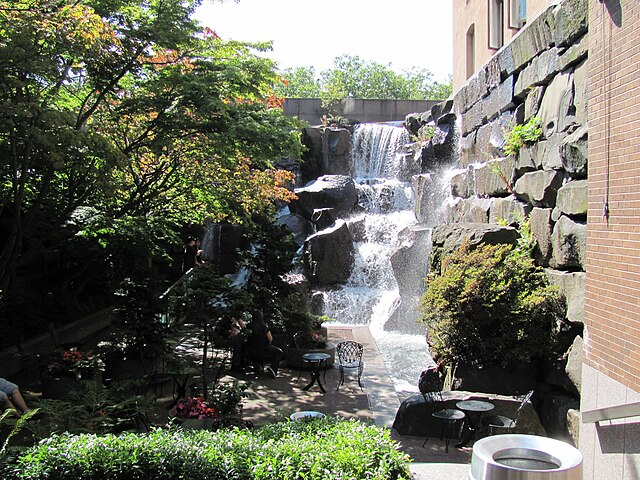A Brief History of the United Parcel Service
August 26, 2024 at 3:31 p.m.
This article is courtesy of HistoryLink.org, the free online encyclopedia of Washington state history
United Parcel Service (UPS), the international package delivery company, grew out of a messenger service established in Seattle in 1907 by an enterprising 19-year-old named James E. "Jim" Casey and his friend, Claude Ryan. Beginning with two bicycles, one phone, a tiny office in the basement of a saloon and $100 borrowed from Ryan's uncle, the two lay the foundation for what became a multi-billion-dollar corporation involved in the flow of goods, funds, and information around the world.
 Claude Ryan and Jim Casey, founders of the United Parcel Service
Claude Ryan and Jim Casey, founders of the United Parcel Service Seattle's population had ballooned from 81,000 in 1900 to nearly 200,000 by 1907. Few homes had telephones, and even fewer had direct communication from one to the other, because the city's two phone companies used completely separate lines. Crosstown communication often required a caller to use a public telephone to dictate a message to a messenger, who then delivered it to the recipient. Most department stores used horse-pulled wagons to deliver merchandise. There were only a few automobiles in the city. The United States Postal Service's parcel post system would not be established for another six years.
Both Casey and Ryan had worked as messenger boys. Casey had been in the workforce since age 11. His father had died in Alaska during the 1897 Klondike gold rush. Young Casey left school soon after that to go to work and help support his mother and siblings. He said later that his father had advised him to "Become a businessman --never work with your hands." Backed by Ryan's uncle, Charley Jones -- who provided office space as well as a stake of $100 -- Casey and Ryan went into business for themselves on August 28, 1907, establishing the American Messenger Service.
The company's original office was a 6-foot by 17-foot space beneath a saloon at Main Street and 2nd Avenue (now the site of Waterfall Park in Pioneer Square, a gift to the city of Seattle from the Casey family). Casey and Ryan advertised by pinning red-and-white posters near public telephones promising the "Best Service at Lowest Prices." They offered 24-hour service seven days a week, including holidays. They used the saloon's lunch counter as a bed with their pillow by the phones.
 Waterfall Garden Park in Seattle's Pioneer District is located at the site of the first UPS office
Waterfall Garden Park in Seattle's Pioneer District is located at the site of the first UPS office
Casey's brother George and a handful of other teenagers were the company's messengers. All the employees wore uniforms and agreed to abide by a strict code of behavior, including courtesy to customers and no whistling. The phones were answered only by those who had learned the proper responses. The messengers ran errands, delivered packages, and carried notes, baggage, and trays of food from restaurants. They made most deliveries on foot and used bicycles or trolley cars for longer trips. The company quickly earned a reputation for prompt and reliable service. By Christmas 1912, it had 100 employees and a second office closer to Seattle's retail district, at 1602 1/2 4th Avenue.
For about two years, the company's largest client was the U.S. Post Office. Until 1913, all special delivery mail entering Seattle was distributed by the American Messenger Service.
The company began to focus on package delivery for retail stores as automobiles and telephones became more common, causing a decline in the messenger business. It also began to use motorcycles for some deliveries. In 1913, it merged with McCabe's Motorcycle Delivery Service and was renamed Merchants' Parcel Delivery, with Casey as president. The new name reflected a shift in the focus of the business from messages to packages. Revenues neared $2,200 per month. The company also bought its first car, a 1913 Model T Ford, and attached a truck bed to its back. By 1915, Merchants' Parcel Delivery was using four autos and five motorcycles, and employing only 20 foot messengers.
The color brown became the company's motif in 1916, at the suggestion of a new associate named Charlie Soderstrom. By 1918, three of Seattle's largest department stores had become regular customers of Merchants' Parcel Delivery, disposing of their own delivery cars and trucks (which Casey and his associates often purchased, painted brown, and added to their growing fleet).
In 1919, the firm made its first expansion beyond Seattle, by buying Motor Parcel Delivery Service in Oakland, California. It also adopted its present name, United Parcel Service (UPS). Three years later, it acquired a company in Los Angeles that had qualified as a "common carrier" -- providing features not then offered by most private delivery services or even by the parcel post, such as daily pickup calls, automatic return of undeliverables, and acceptance of checks made out to the shipper in payment of "Collect on Delivery" (or CODs). The acquisition of this company and the decision to expand the common carrier service influenced the growth of UPS for years to come.
By 1927, UPS had expanded to include all the major cities on the Pacific Coast. It extended its reach to the East Coast in 1930. In the 1950s, the company began seeking common carrier rights to deliver packages between all customers, both private and commercial, throughout the United States -- a decision that put UPS in direct competition with the U.S. Postal Service and led to a series of legal battles that continued, off and on, for about 30 years.
The company eventually moved its headquarters to California, then to New York, then to Atlanta. Jim Casey retired from active management in the 1960s and turned more of his attention to the Annie E. Casey Foundation. He and his siblings -- George, Harry, and Marguerite -- had established the Foundation in 1948, in honor of their mother. Its first grants provided support for a camp for disadvantaged children in Seattle. In 1966, Casey sharpened the focus of the Foundation to the welfare of children in long-term foster care. Casey Family Programs, now an independent foundation based in Seattle, offers an array of services to support children in foster care.
Casey died in 1983. His estate provided additional resources for the Annie E. Casey Foundation, headquartered in New Haven, Connecticut, which continues to work on behalf of disadvantaged children.
Sources:
"A Century of Business," Puget Sound Business Journal, September 17, 1999; Junior Achievement of Greater Puget Sound Hall of Fame Series; "Company History," UPS Website, accessed September. 15, 2004 (http://www.ups.com/content/corp/about/history/index.html); "About AECF," Annie E. Casey Foundation Website, accessed September 15, 2004 (http://www.aecf.org/about/history.htm).
Note: This essay was updated on September 16, 2004.





